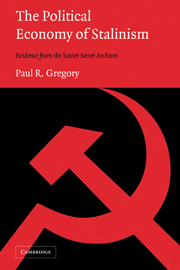Book contents
- Frontmatter
- Contents
- Illustrations
- Tables
- Preface
- 1 The Jockey or the Horse?
- 2 Collectivization, Accumulation, and Power
- 3 The Principles of Governance
- 4 Investment, Wages, and Fairness
- 5 Visions and Control Figures
- 6 Planners Versus Producers
- 7 Creating Soviet Industry
- 8 Operational Planning
- 9 Ruble Control: Money, Prices, and Budgets
- 10 The Destruction of the Soviet Administrative-Command Economy
- 11 Conclusions
- Appendix A Archival Sources
- Appendix B The Structure of the State
- Bibliography
- Index
4 - Investment, Wages, and Fairness
Published online by Cambridge University Press: 03 December 2009
- Frontmatter
- Contents
- Illustrations
- Tables
- Preface
- 1 The Jockey or the Horse?
- 2 Collectivization, Accumulation, and Power
- 3 The Principles of Governance
- 4 Investment, Wages, and Fairness
- 5 Visions and Control Figures
- 6 Planners Versus Producers
- 7 Creating Soviet Industry
- 8 Operational Planning
- 9 Ruble Control: Money, Prices, and Budgets
- 10 The Destruction of the Soviet Administrative-Command Economy
- 11 Conclusions
- Appendix A Archival Sources
- Appendix B The Structure of the State
- Bibliography
- Index
Summary
“The USSR is a generous country. It sends grain abroad, but is itself hungry.”
“Let those compete who are full.”
“We can't do the five-year plan in four years. It should not be completed on the bones of workers.”
“Welcome the Five-Year Plan with empty stomachs.”
(Graffiti on factory walls in 1930)The Soviet dictator — the Politburo or (later) Stalin alone — had to define its goals, what economists call its “objective function.” An objective function specifies the goals of a person or organization (e.g., an enterprise) along with the relative weights (importance) attached to each goal. Abram Bergson used the term planners' preferences as a convenient shorthand for the Soviet dictator's objective function, be it the objectives of the Stalin dictatorship or of the collective postwar leadership. Planners' preferences refers to the fact that the administrative-command economy was directed by the general party line — unlike market economies that are ultimately directed by consumer sovereignty.
Clearly, the Politburo had multiple objectives in the 1930s, but, despite rumors of ideological splits, there was indeed a basic consensus for a secure power base, maximum economic growth, investment in heavy industry, and transferring resources out of the countryside. After embarking on the Great Break-Through, there was no turning back. The fate of Stalin and his Politburo team hinged on its success. Stalin and his compatriots truly believed their own propaganda: they were surrounded by antisocialist wreckers, antagonistic kulaks, and domestic and foreign enemies; immediate industrialization was required for survival.
- Type
- Chapter
- Information
- The Political Economy of StalinismEvidence from the Soviet Secret Archives, pp. 76 - 109Publisher: Cambridge University PressPrint publication year: 2003



